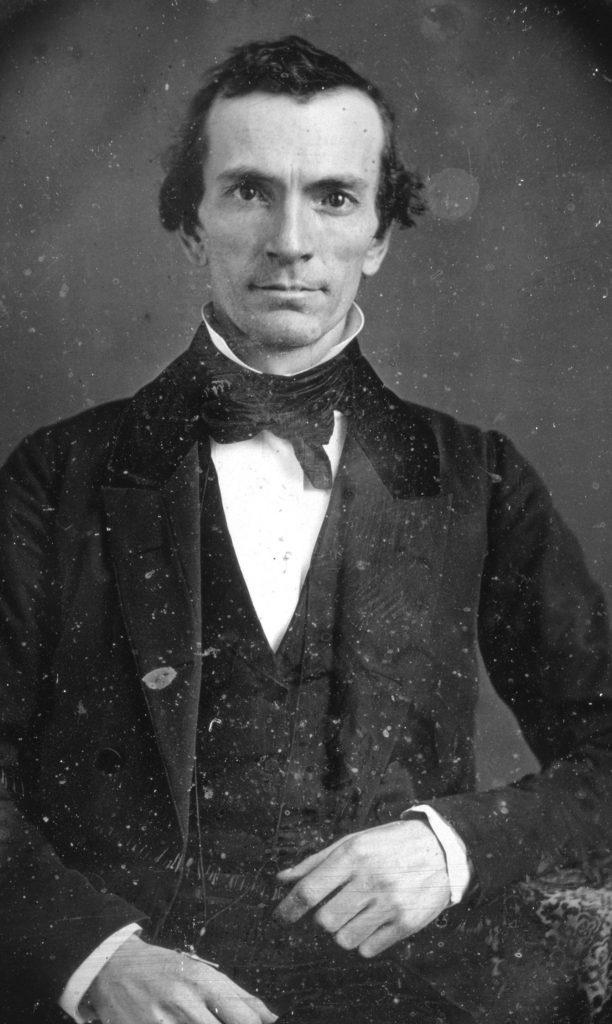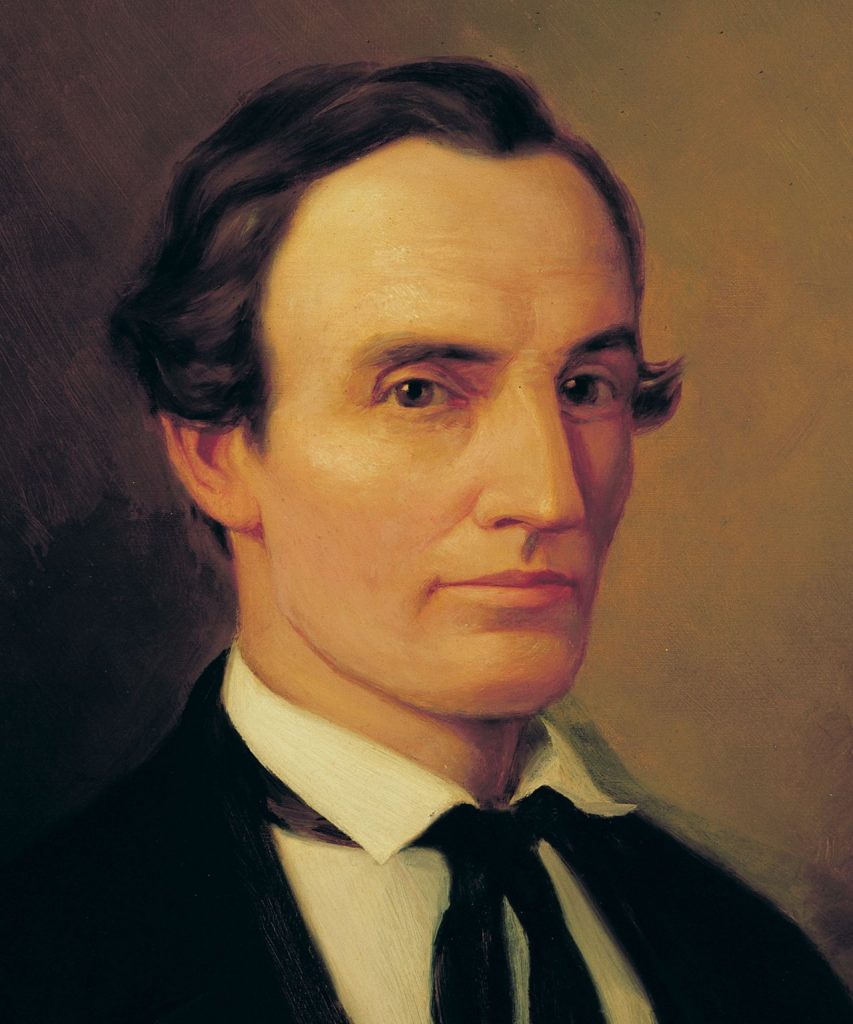Oliver Cowdery
(1806-1850)




D&C 6; 7; 8; 9; 13; 17; 18; 20:3; Introduction to 21; 21:10, 12, 23-24, 26; 28; 30:5; 32:2; 55:4; 57:13; 58:58; 61:23, 32; Introduction to 63; 63:46; Introduction to 67; 68:32; 70:3; 82:11; Introduction to 102; 102:3, 34; 104:28–29, 34; 110; Introduction to 111; 124:94-95
By Susan Easton Black
After receiving his education in Vermont and New York, Oliver became a schoolteacher. While teaching school in Manchester, New York in 1829, he learned of Joseph Smith and his angelic visitations. When the school term ended in April 1829 Oliver and Samuel Smith, the brother of Joseph Smith, journeyed to Harmony, Pennsylvania, for the purpose of seeing Joseph and learning more about his heavenly visitations and the gold plates. “Near the time of the setting of the Sun, Sabbath evening, April 5th, 1829, my natural eyes, for the first time beheld this brother,” wrote Oliver. “On Tuesday the 7th, [I] commenced to write the book of Mormon.”1
From April 1829 to April 1838 Oliver Cowdery was a close associate and friend of the Prophet Joseph. He scribed most of the Book of Mormon as Joseph translated the sacred writ. On May 15, 1829 he and Joseph received the Aaronic Priesthood on the banks of the Susquehanna River from John the Baptist and the Melchizedek Priesthood from ancient apostles Peter, James, and John a few weeks later. Several of the early revelations in the Doctrine and Covenants were instructions to Oliver, who was named the second elder of the Church at the organizational meeting in Fayette, New York.
Oliver’s sacrifice to share the message of the Restoration from New York to the western frontier of the United States bespeaks his commitment to the Lord. Of Oliver’s ability to stir the hearts of men to greater good Wilford Woodruff wrote, “I have seen Oliver Cowdery when it seemed as though the earth trembled under his feet. I never heard a man bear a stronger testimony than he did when under the influence of the Spirit.”2 No wonder on December 5, 1834 Oliver was ordained an assistant to the Prophet Joseph. On that occasion Joseph said, “I lay my hands upon thee and ordain thee an assistant-president to the High and Holy Priesthood, in the Church of the Latter-day Saints.”3 On April 3, 1836 Oliver was with Joseph as priesthood keys were received from ancient prophets Elijah, Elias, and Moses in the Kirtland Temple.
Although Oliver stands alone as the contemporary who received many glorious manifestations with the Prophet Joseph Smith, nine formal charges were drawn against him on April 7, 1838 before the Far West high council, including the charge that he urged vexatious law suits be brought against the Saints and the charge that he sought to destroy the character of the Prophet Joseph. Oliver refused to attend the high council meeting when the charges were discussed. “Give me my freedom or take my life!” he wrote. “I shall no longer be bound by the chains of hell. I shall speak out when I see a move to deceive the ignorant.”4 After deliberating on the charges against Oliver, the Far West high council excommunicated him on April 12, 1838.
Although Oliver had lost fellowship with the Saints, Joseph Smith continued to reach out to him and encouraged the Quorum of the Twelve to do the same: “Write to Oliver Cowdery and ask him if he has not eaten husks long enough? If he is not almost ready to return, be clothed with robes of righteousness, and go up to Jerusalem?”5 For years, Oliver rejected their entreaties.
During those years, he was a lawyer in Tiffin, Ohio and in Elkhorn, Wisconsin. Of his legal work Oliver said, “My business is steadily increasing—nothing operates against me, except the fact that I have formerly been connected with what is now an important church.”6 Yet he wrote on February 14, 1847 to Phineas Young, “No day passes without our thoughts being turned toward our relatives and loved friends, who are toiling and struggling in the far off wilderness, during a cold and pitiless winter” and expressed interest in returning to Church fellowship.7
On November 11, 1847 Brigham Young wrote to Oliver:
Return to our father’s house, from whence thou hast wandered, and partake of the fatted calf and sup and be filled, and renew thy testimony to the truth of the Book of Mormon with a loud voice, and faithful heart and you will soon feel the Holy Ghost burning your bones like fire in the dry stubble . . . and the Saints, His sons and daughters will with open arms hail thee as their long lost brother found in the New and Everlasting Covenant.8
Oliver journeyed from Elkhorn to Kanesville, Iowa to be with the Saints. At a conference held on October 21, 1848 at Kanesville, he addressed the assembled by saying, “Friends and Brethren—My name is Cowdery—Oliver Cowdery. In the early history of this Church I stood identified with her, and one in her council . . . I wrote, with my own pen, the entire Book of Mormon (save a few pages) as it fell from the lips of the Prophet Joseph Smith. . . .That book is true.” In early November 1848 Oliver requested that the Kanesville high council to grant him fellowship in the Church: “Brethren, for a number of years, I have been separated from you. I now desire to come back. I seek no station. I only wish to be identified with you.”9 Upon the motion of Orson Hyde, Oliver Cowdey was welcomed back into Church fellowship.
After his baptism, Oliver helped Orson Hyde publish the Frontier Guardian newspaper until April 1849. He then journeyed with his wife Elizabeth Whitmer Cowdery to Richmond, Missouri, to visit her family. From Richmond, Oliver wrote of his struggles with his “old difficulty of the lungs.” Just before his death on March 3, 1850 at the David Whitmer home in Richmond, Oliver admonished his loved ones “to live according to the teachings set forth in the Book of Mormon and he promised them that if they were faithful to this they would be assembled with him in Heaven.”10
1. Oliver Cowdery, Messenger and Advocate 1, no. 1 (October 1834), p. 14.
2. “Testimony of Wilford Woodruff,” Deseret News Weekly, 35:391, as cited in Stanley R. Gunn, Oliver Cowdery: Second Elder and Scribe (Salt Lake City: Bookcraft, 1962), p. 73.
3. Ordination and Blessing of Oliver Cowdery, 5 December 1834. Joseph Smith Papers.
4. Huntington Library Letters, microfilm #87, as cited in Gunn, Oliver Cowdery, p. 230
5. History, 1838-1856, volume D-1, [1 August 1842-1 July 1843]. Joseph Smith Papers.
6. Letter of Oliver Cowdery to Phineas H. Young, August 19, 1842, Tiffin, Ohio, as cited in Gunn, Oliver Cowdery, p. 169.
7. Letter of Oliver Cowdery to Phineas H. Young, February 14, 1847, Tiffin, Ohio, as cited in Gunn, Oliver Cowdery, p. 187.
8. Letter of Brigham Young to Oliver Cowdery, November 22, 1847, as cited in Gunn, Oliver Cowdery, pp. 191-193.
9. Andrew Jenson, Latter-day Saint Biographical Encyclopedia (Salt Lake City: Deseret Book, 1936), 1:249-250.
10. Oliver Cowdery quote, in Gunn, Oliver Cowdery, p. 209.
Additional Resources
- Biography of Oliver Cowdery (josephsmithpapers.org)
- KnoWhy #54 – Who Are the “Few” Who Were Permitted to See the Plates?
- KnoWhy #267 – Why Were Three Witnesses Chosen to Testify of the Book of Mormon?
- KnoWhy #270 – How Important was Oliver Cowdery in Bringing Forth the Book of Mormon?
- KnoWhy #279 – Why Did Joseph and Oliver Seek Authority to Baptize?
- KnoWhy #403 – Are the Accounts of the Golden Plates Believable?
- KnoWhy #405 – Why Were the Three Witnesses Shown the Liahona?
- KnoWhy #453 – How Are Oliver Cowdery’s Messenger and Advocate Letters to Be Understood and Used?
- KnoWhy #521 – Did the Book of Mormon Witnesses Really See What They Claimed?
- KnoWhy #596 – Why Did the Lord Command the Three Witnesses to Rely upon His Word?
- KnoWhy #603 – Why Was Oliver Cowdery Excommunicated from the Church?
- KnoWhy #605 – Why Did Oliver Cowdery Come Back to the Church?
